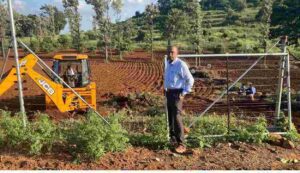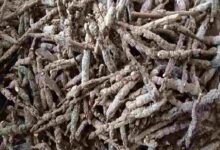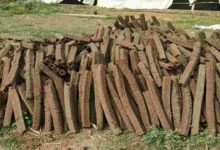Success Story: Know how R. Narasimhan earned 50 lakh rupees annually from mangoes, bananas, wood and training
Success Story: R. Narasimman had no idea how big what he was building would become when he left his corporate position in 1998 to become an entrepreneur and pursue farming. The plan was simple: he would set up a farm for peaceful life after retirement. However, fate had other plans. He started his quest with two acres of property and a strong love for the land. His vision quickly grew to include 80 acres of Alphonso mangoes in and around Trichy.

Monoculture quickly exposed its weaknesses, however, including erratic weather patterns, erratic markets, and a lack of reliable revenue streams. At that point, he came up with the idea for a different model: unified agroforestry, in which no acreage is left vacant. He now uses a three-tiered approach. The highest level is set aside for long-term investments such as silver oak, teak, red sanders, and rosewood trees, which take 15 to 20 years to mature and provide crores in future income.
Mangoes, bananas, and watermelons are horticultural crops that consistently provide profits at the intermediate level. Seasonal returns are provided at the ground level by pulses such as green and black grams. He grows 1,500 cashew trees and 25,000 silver oaks on his land alone, bringing in between Rs. 10 and Rs. 15 lakh a year.
According to Narasimman, “agroforestry is more than just planting trees.” “Creating a financial safety net for future generations is the goal.” He just became a member of Krishi Jagran’s Global Farmer Business Network (GFBN), an initiative that supports prosperous and sustainable agribusiness owners.
When a Watermelon Made News Around the Nation
A single watermelon weighing 35.75 kg achieved a national record in 2010, marking a fantastic milestone for Narasimman’s farm. Astonished by the magnitude, the seed company Namdhari called him to Bengaluru, saying that not even their worldwide wholesalers in seven countries had seen such a result. An entirely organic ecology is his secret.
In 2008, he transitioned to organic farming, using the compost produced by his 16 Desi cows. sun-powered drip irrigation efficiently conserved water, and a 700 square foot sun dryer made it easier to turn fruits into goods with additional value. As shown by the later sale of that unusual watermelon for Rs. 5,000, organic quality is valued higher even in the local market.
From Farmer to Advisor on National Policy
National leaders soon took note of Narasimman’s novel agricultural technique. In 2018, Prime Minister Narendra Modi asked him to provide ideas for the policy strategy aimed at doubling farmers’ income. One of his 22 recommendations was to cut out intermediaries from the distribution of subsidies. He was urged to consult the Supreme Court over changes to the Minimum Support Price (MSP) when he was at the 2020 farmer protests.
In addition, he is now supporting new farmers implementing organic-agroforestry systems as a senior mentor. He has impacted other farmers via his training programs and mentorship, and they have transformed acres of farmland according to his ideas.
A Livable, Self-Sustained Farm Ecosystem
The self-sufficiency design of Narasimman’s device is what makes it even more unique. built over many decades using solar power, rainwater collection, diverse agriculture, and layers of lush forest canopies. Without human assistance, his farm can sustain itself and provide food for up to 20 years. This creates an ecological equilibrium that guarantees food diversity, soil health, and pest control based on nature.
Developing the Upcoming Agri-Leaders
Narasimman is not only building a prosperous agro-business but also fostering agriculture for future generations. He provides students ranging from B.Sc. to Ph.D. with free on-the-ground training. Today, his property serves as a living laboratory for young people interested in learning about organic farming, agroforestry, and soil science. His words, “I don’t want this to die with me,” “This knowledge must live on.”
It’s interesting to note that his son, a doctor who now lives in Germany, used to giggle at the thought of farming. He is eager to learn and now comes to the farm often. “Teach me, Appa,” he adds with renewed reverence.
The Path Ahead: Agritourism and Swadeshi Timber
In order to promote sandalwood and native timber trees, Narasimman has recently partnered with the Indian Forest Genetic Institute. His goal is to reduce India’s dependency on imported lumber by enabling farmers to profitably produce local, quickly growing kinds. In order to provide city people and students a chance to see the agroforestry concept in action, he also intends to implement agritourism.
He thinks that India can eliminate wood imports in ten years if all farmers plant only ten trees a year. He exhorts, “Imagine beyond rice and wheat.” “A bank account is soil. Your pension is a tree. The earth will repay your grandkids if you treat it with respect.
A Legacy That Lives On
R. Narasimman has won more than 60 honors, including those from the Indian Chamber of Food and Agriculture and NITI Aayog, proving that agriculture is not only viable but also forward-thinking.
His Trichy farm is a model of prosperity, sustainability, and tenacity. Every leaf in his field has a tale to tell—one of growth, but also of perseverance, faith, and purpose.
He often declares, “Farming isn’t a job,” as he walks among the 40-foot teak trees. “It’s a 100-year investment.”

